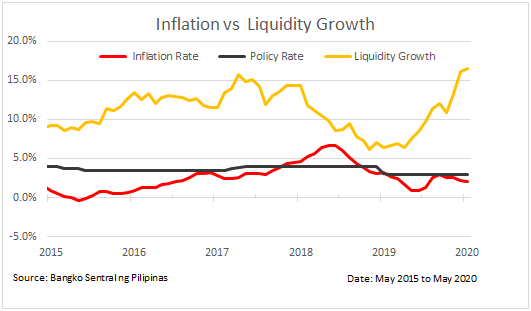MONDAY MACRO: Uniform Accounting reveals why excessive liquidity from rising inflation should still be of little concern

Philippine inflation reached a three-month high of 2.5% this past June. Following relaxed COVID-19 measures, it is unsurprising that inflation levels are its highest since March as the economy slowly reopens.
Even though inflation levels show an increase in economic activity, will the BSP’s efforts be enough to stimulate growth in this low inflationary economy? Uniform Accounting provides insight as to what to expect for business conditions amidst the pandemic.
Philippine Markets Daily:
The Monday Macro Report
Powered by Valens Research
Bank lending tightened last May as the community quarantine continues to impact the local economy.
Historically, tighter credit standards have been a very early signal that a recession will occur in the near future because limited lending could subdue growth potential, as stated in our March 30th report.
Fortunately, in addition to transportation restrictions easing, businesses are now slowly adapting, although at a limited capacity. Credit activity for businesses should follow as well. This will result in inflation further improving as overall activity and aggregate demand increases.
Costs of transportation, housing, and utilities saw significant increases last month, with transport prices rebounding from -5.6% in May to 2.3% in June and the cost of housing and utilities increasing from 0.2% to 0.4%.
In our May 11th report, we discussed how inflation or an increase in prices is an important consideration in cutting policy rates. Because of the low-inflation environment, improvement in the credit circulation through BSP’s tools is still expected. Moreover, the BSP has signaled that they would likely sustain an accommodative policy at least for the next two years.
Despite the lack of bank lending activities, domestic liquidity has grown the fastest in almost six years as a result of past rate cuts from the BSP and increased credit demand.

Domestic liquidity is the amount of money in circulation within the local financial system.
After jumping from 8.6%-9.7% levels in 2015 to 11% in January 2016, liquidity growth improved further to 15.8% by August 2017, before falling to a 5-year low of 6.3% in August 2019. Since then, liquidity growth has expanded to 16.6% last May 2020.
The sustainable domestic liquidity around the Philippine economy should entice banks to further lend to their clients.
Moreover, given the expectation of higher increases in the inflation rate as the economy recovers, domestic liquidity year-over-year growth rate is expected to further improve for the remainder of the year due to its historical positive relationship with the inflation rate.
Despite this, the consequences of increased liquidity will likely be of little concern to the economy as inflation levels remain manageable, and with the Philippine currency proving to be resilient due to the country’s comfortable level of gross international reserves (GIR).
Additionally, BSP has plans to issue its own bonds by Q3 2020. By integrating its electronic trading platform, and that of the Bureau of the Treasury, the BSP should be able to effectively use its monetary policy tools.
Furthermore, as we discussed in our June 1st report, the largest Philippine companies continue to enjoy a healthy cash profile for the next five years. If a recession should occur, the Philippines’ largest companies will aid in the swift recovery of the economy.
About the Philippine Market Daily
“The Monday Macro Report”
When just about anyone can post just about anything online, it gets increasingly difficult for an individual investor to sift through the plethora of information available.
Investors need a tool that will help them cut through any biased or misleading information and dive straight into reliable and useful data.
Every Monday, we publish an interesting chart on the Philippine economy and stock market. We highlight data that investors would normally look at, but through the lens of Uniform Accounting, a powerful tool that gets investors closer to understanding the economic reality of firms.
Understanding what kind of market we are in, what leading indicators we should be looking at, and what market expectations are, will make investing a less monumental task than finding a needle in a haystack.
Hope you’ve found this week’s macro chart interesting and insightful.
Stay tuned for next week’s Monday Macro report!
Regards,
Angelica Lim
Research Director
Philippine Markets Daily
Powered by Valens Research
www.valens-research.com




